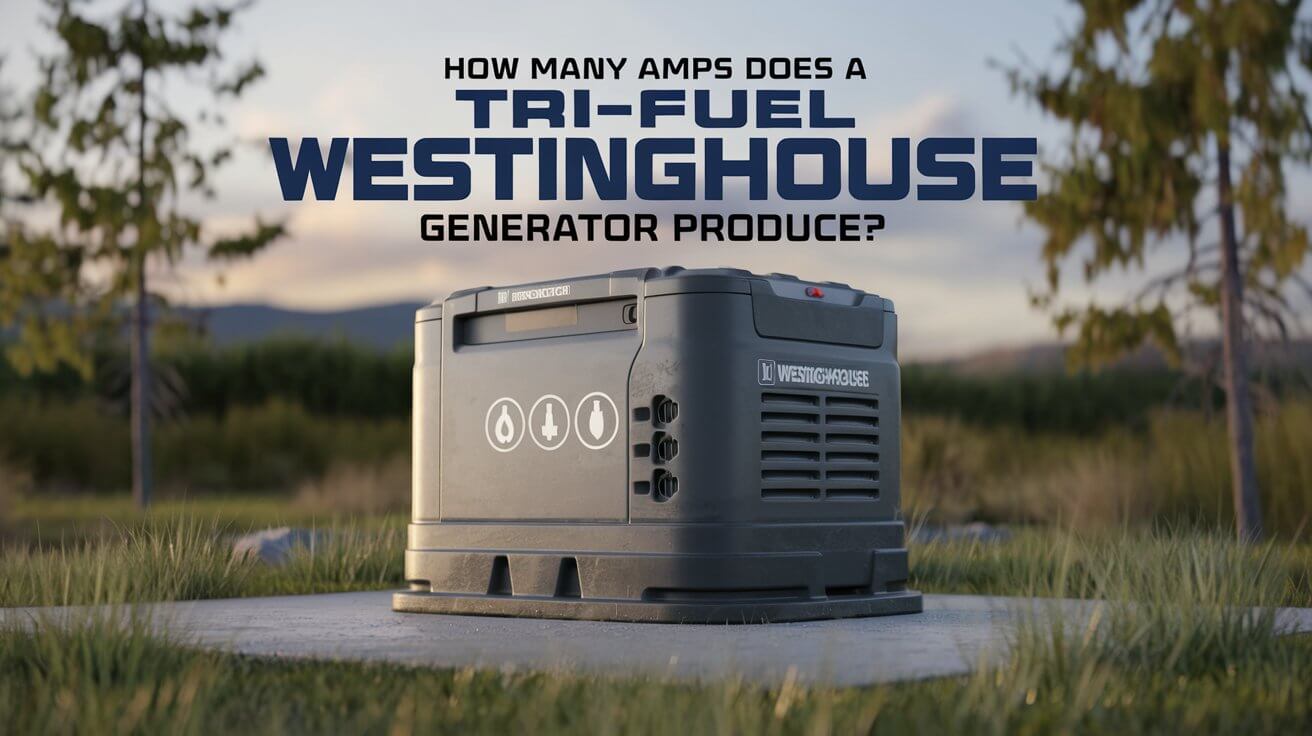How Many Amps Does a Tri-Fuel Westinghouse Generator Produce?

Choosing the right generator for your power needs is critical, especially when dealing with power outages or looking for reliable energy on job sites or camping trips. When it comes to tri-fuel Westinghouse generators, one common question arises: how many amps does a tri-fuel Westinghouse generator produce? In this blog post, we’ll dive into the technical specs of these generators, discuss how amperage works, and break down the amp output across various fuel types.
Tri-fuel generators from Westinghouse, such as the WGen9500TFc and WGen10500TFc, are versatile machines that can run on gasoline, propane, or natural gas. These generators provide varying levels of power output depending on the fuel source, which, in turn, affects the number of amps they can generate.
Overview of Tri-Fuel Westinghouse Generators
What is a Tri-Fuel Generator?
A tri-fuel generator is designed to run on three types of fuel: gasoline, propane (LPG), and natural gas. This versatility allows users to choose the most readily available or convenient fuel, especially during emergencies. Tri-fuel generators are especially handy for home backup power, construction sites, RVs, and outdoor activities, ensuring you can always keep your essential devices running no matter what fuel is available.
Types of Westinghouse Tri-Fuel Generators
Westinghouse offers several popular tri-fuel generator models, each designed to provide reliable power in various settings. Two standout models are the WGen9500TFc and the WGen10500TFc. These generators are equipped with powerful engines and modern technology to deliver dependable energy, whether you’re at home or on the road. Here’s a breakdown:
- WGen9500TFc: Peak power of 12,500 watts and 9,500 running watts on gasoline, with lower outputs for propane and natural gas.
- WGen10500TFc: Slightly more powerful, delivering 13,000 peak watts and 10,500 running watts on gasoline.
Both models feature electric start, CO sensors, and enough outlets to power everything from large appliances to sensitive electronics. The type of fuel you choose affects the overall power output, which we’ll explore in detail.
Understanding Power Output in Watts and Amps
The Relationship Between Watts, Volts, and Amps
Before jumping into how many amps a tri-fuel Westinghouse generator produces, let’s clarify the relationship between watts, volts, and amps. The power a generator produces is measured in watts (W), while volts (V) represent the electrical pressure, and amps (A) measure the flow of electricity.
The formula to calculate amps is:
Amps = Watts ÷ Volts
For example, if a generator is producing 12,500 watts at 120 volts, it’s delivering about 104 amps. Similarly, if it’s running on natural gas and produces 7,500 watts at 240 volts, the amp output would be about 31 amps.
Peak and Rated Watts
When assessing generator power, it’s essential to understand the difference between peak (or surge) watts and rated (or running) watts:
- Peak watts refer to the maximum power the generator can produce in a short burst, typically when starting up heavy appliances.
- Rated watts are the consistent power level the generator can maintain over time.
For example, the Westinghouse WGen9500TFc has a peak wattage of 12,500 watts on gasoline but delivers a steady 9,500 running watts. This fluctuation affects how many amps the generator produces during normal operation.
How Many Amps Do Westinghouse Tri-Fuel Generators Produce?
WGen9500TFc Amps on Different Fuels
The Westinghouse WGen9500TFc is a powerful tri-fuel generator that delivers different levels of power depending on the fuel type. Here’s the breakdown of amps across gasoline, propane, and natural gas:
- Gasoline: The WGen9500TFc produces up to 79 amps at 120V with a peak wattage of 12,500 watts. It provides 79.2 amps at 120V during normal operation with its 9,500 running watts.
- Propane (LPG): When running on propane, the WGen9500TFc outputs 71 amps at 120V, producing 8,500 running watts and 11,200 peak watts.
- Natural Gas: On natural gas, this generator produces 62.5 amps at 120V, with a peak wattage of 9,500 watts and running power of 7,500 watts.
This flexibility makes the WGen9500TFc an excellent choice for homeowners or job sites, providing reliable power in various conditions.
WGen10500TFc Amps on Different Fuels
The WGen10500TFc takes power a step further. Here’s how many amps this model produces on different fuel sources:
- Gasoline: Running on gasoline, the WGen10500TFc produces 108 amps at 120V, thanks to its impressive 13,000 peak watts and 10,500 running watts.
- Propane: On propane, this model delivers 79 amps at 120V with a peak wattage of 12,000 watts and running power of 9,500 watts.
- Natural Gas: Using natural gas, the WGen10500TFc generates 70.8 amps at 120V, with a peak of 10,000 watts and running watts of 8,500.
Amp Usage for Common Appliances and Tools
Household Appliances
Understanding how many amps your household appliances require is essential when choosing the right generator. Here’s an overview of common appliances and their typical amp draw:
- Refrigerator: 5-7 amps
- Air Conditioner: 15-20 amps (depending on size)
- Sump Pump: 10-15 amps
- Lights: 0.5-2 amps per bulb
- TV: 1-3 amps
If you need to run multiple appliances during a power outage, you’ll need to calculate the total amps required and compare that to your generator’s output. For example, if your refrigerator, air conditioner, and lights combined need 35 amps, you’ll need a generator that can deliver that at your desired voltage.
Tools and Outdoor Equipment
For job sites, the amp requirements can vary greatly depending on the equipment being used:
- Power Drill: 2-4 amps
- Table Saw: 15 amps
- Air Compressor: 10-30 amps
- Circular Saw: 12-15 amps
The Westinghouse tri-fuel generators provide enough power to handle multiple tools at once, making them ideal for contractors and outdoor workers.
Runtime and Fuel Efficiency of Westinghouse Tri-Fuel Generators
Fuel Consumption Rates
Fuel consumption and runtime vary depending on the fuel type and load. For example, the WGen9500TFc runs for up to 12 hours at 25% load on gasoline, thanks to its 6.6-gallon tank. On propane, it can run for up to 7 hours on a standard 20 lb. tank. Natural gas consumption is typically lower, but the runtime is highly dependent on the natural gas supply and load.
Calculating Runtime Based on Amp Draw
When calculating how long your generator will run, consider the total amp draw from your appliances or tools. Generators tend to last longer when operating at lower loads. For instance, if you’re only using half the generator’s rated capacity, your fuel efficiency will improve, and your runtime will increase.
Factors to Consider When Choosing a Westinghouse Tri-Fuel Generator
Determining Power Needs
To select the right Westinghouse tri-fuel generator, calculate your total amp needs based on the devices you plan to power. If you’re looking for a generator to power essential appliances during an outage, consider a model with at least 8,000 running watts. If you need to power a job site with multiple tools, a higher-wattage model like the WGen10500TFc may be the best option.
Price vs. Performance
Westinghouse tri-fuel generators offer a balance between power output and price. For instance, the WGen9500TFc typically retails for around $1,399, while the WGen10500TFc is slightly more expensive at $1,449. Both models come with a 3-year warranty, providing peace of mind for long-term use.
Conclusion
Westinghouse tri-fuel generators, such as the WGen9500TFc and WGen10500TFc, are versatile, powerful, and efficient machines capable of delivering high amp outputs across various fuel types. Whether you’re powering your home during an outage or running multiple tools on a job site, these generators provide the flexibility and reliability you need.
By understanding how many amps each model produces on gasoline, propane, and natural gas, you can select the right generator for your specific needs. Whether you’re aiming for a 62-amp output on natural gas or an impressive 108 amps on gasoline, Westinghouse tri-fuel generators ensure that you’re never left in the dark.



